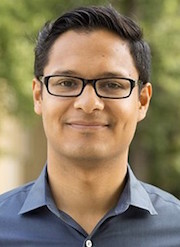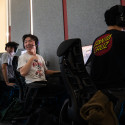Professor studies impact of Chicago gang violence
Robert Vargas, an assistant professor of sociology at UW–Madison, didn’t set out to study gang violence in impoverished Chicago neighborhoods, but once he saw its power over the community, he quickly shifted his area of research.
While he was working on his doctorate at Northwestern University, Vargas initially wanted to study the education performance of youth. But his research changed once he saw how the threat of gang violence affected children at a local youth group.

Robert Vargas
“One day, some kid came in and said, ‘Be careful, there’s a gang initiation going on and there might be a shooting,’” Vargas says. “All these kids immediately scrambled to figure out what route they’re going to take home and whether they should call their parents to get a ride.”
Vargas realized that before he could comprehend his original research topic of youth education, he needed to understand the impact of gang violence.
“It just showed me that so many problems we have in our society are just exacerbated by the threat of violence that these kids face,” says Vargas. “You can build great schools and great community programs, but if these kids don’t feel safe walking around in their own neighborhood, it’s kind of a moot point.”
After shifting his research topic, Vargas started by surveying 60 randomly selected blocks in Chicago to get a sense of how local residents perceived gang violence. Some believed it was the worst in recent memory, and many who felt this way attributed it to the recent arrest of a gang leader. The residents thought this encouraged rival groups to fight over the newly vacant territory.
Vargas checked these claims against crime data, and sure enough, there was a spike in violence in the month following that leader’s arrest. This led Vargas to question the value of arresting leadership.
“You can build great schools and great community programs, but if these kids don’t feel safe walking around in their own neighborhood, it’s kind of a moot point.”
Robert Vargas
“It’s remarkable how much we actually don’t know about the effectiveness of taking out the leadership of organized crime,” Vargas says. “It’s one of the most common ways that law enforcement go after criminal groups, but it’s also one of the most understudied interventions.”
Vargas believes further research needs to account for the relationships between gangs. Arresting a gang’s leader doesn’t just affect that one group — it affects rivals, suppliers and allies as well. A greater understanding of those relationships would help ensure that violence intervention doesn’t backfire.
“Targeting one group isn’t going to be effective because another group is going to come and take their spot,” Vargas says. “I feel like the ideal thing is if you’re going to disrupt a relationship, you need to supplement that by doing something to mend that relationship.”
Vargas will further explore the topic of violence in certain Chicago neighborhoods in his book that will come out next year, tentatively titled Grassroots Gangsters: Politics, Governance, and Violence Prevention in Chicago.
—Jim Dayton
Tags: poverty, research, UW-Madison Police



